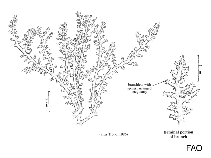Acanthophora spicifera (M. Vahl) Børgesen, 1910
Erect sea moss| Native range | All suitable habitat | Point map | Year 2050 |

|
| This map was computer-generated and has not yet been reviewed. |
| Acanthophora spicifera AquaMaps Data sources: GBIF OBIS |
Google image | No image available for this species;
drawing shows typical species in Rhodomelaceae.
Classification / Names Common names | Synonyms | CoL | ITIS | WoRMS
Florideophyceae | Ceramiales | Rhodomelaceae
Environment: milieu / climate zone / depth range / distribution range Ecology
Sessile; depth range 0 - 19 m (Ref. 83908). Tropical
Distribution Countries | FAO areas | Ecosystems | Occurrences | Introductions
Atlantic Ocean: from USA to southeast Brazil, including Gulf of Mexico, Bermuda and the Caribbean, east to Mauritania and south to Angola, including Equatorial Guinea and São Tomé and Príncipe; Indian Ocean: from the Arabian Sea, including the Persian Gulf, Gulf of Oman, and the Red Sea, south to South Africa, including Aldabra Islands, Seychelles and Réunion, east to Sri Lanka, including Laccadive Islands and Maldives; in the Bay of Bengal, south to Dampier Archipelago, Western Australia, including Andaman and Nicobar Islands; Pacific Ocean: from China to the South China Sea, south to Lord Howe Island, including Spermonde Archipelago and Federated States of Micronesia, Solomon Islands and New Caledonia, east to the Hawaiian Islands, including Fiji, French Polynesia and the Samoan Archipelago.
Length at first maturity / Size / Weight / Age
Maturity: Lm ? range ? - ? cm
Short description Morphology
Life cycle and mating behavior Maturity | Reproduction | Spawning | Eggs | Fecundity | Larvae
Main reference
References | Coordinator | Collaborators
Guiry, M.D. and G.M. Guiry 2009 AlgaeBase. World-wide electronic publication, National University of Ireland, Galway. http://www.algaebase.org; searched on 14 April 2009. (Ref. 80701)
IUCN Red List Status
(Ref. 130435: Version 2025-1)
CITES status (Ref. 108899)
CMS (Ref. 116361)
Threat to humans
Human uses
Fisheries: commercial
| FishSource |
Tools
More information
Diet composition
Food consumption
Predators
Max. ages / sizes
Length-weight rel.
Length-length rel.
Length-frequencies
Mass conversion
Abundance
Maturity
Fecundity
Spawning
Eggs
Egg development
Larvae
Internet sources
BHL | BOLD Systems | CISTI | DiscoverLife | FAO(Publication : search) | Fishipedia | GenBank (genome, nucleotide) | GloBI | Gomexsi | Google Books | Google Scholar | Google | PubMed | AlgaeBase | Tree of Life | Wikipedia (Go, Search) | Zoological Record



